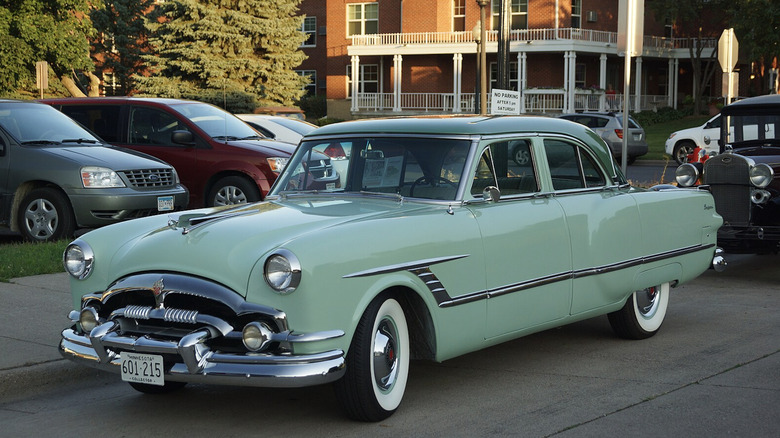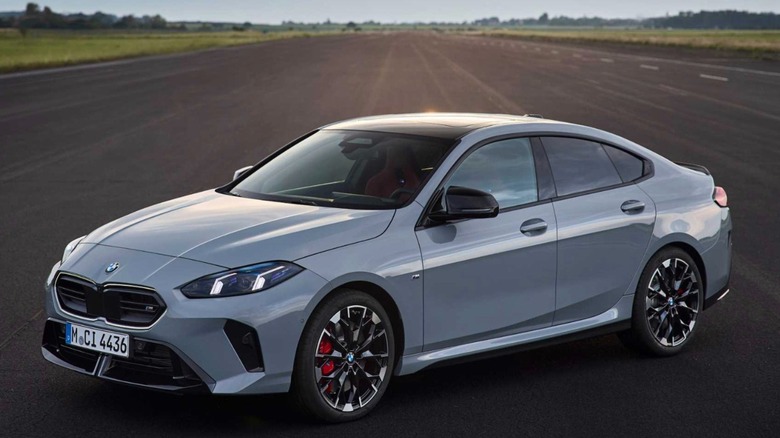The World's First Self-Parking Car Was More Clever Than You Might Think
Along with other driving-assistance features, automakers have been steadily introducing self-parking in newer car models. However, the technology has been around for a quite a while, with the first self-parking patent filed way back in 1938. This patent was secured by Brooks Walker, a lumber worker in California who came up with a way to get more out of the spare tire many vehicles at the time kept at the vehicle's rear.
Specifically, the design was for parallel parking, and pulling your car out of very tight spaces. The way Walker's "Park Car" concept worked was that the fifth wheel, aligned perpendicular to the curb, would lower to the ground and briefly lift up the rest of the vehicle like a jack. As the narrator of a decades-old film showcasing the invention describes: "Taking power from the drive shaft, the spare tire swings the rear end into the clear."
Essentially, the lifted car swiveled at an angle that made it much easier for the driver to back out of the spot. Once the car reached this angle, it would lower back down and the fifth wheel would retract. Because the chassis of the vehicle could turn a full 360 degrees with the fifth wheel planted firmly on the ground, Walker's invention also allowed drivers to make tight 90-degree turns into parking spots, driveways, or garages that were perpendicular just off the road as well.
Walker built a working model that showed his concept worked flawlessly in practice. Given that parallel parking is the bane of drivers' existence even to this day, you'd think a self-parking feature would've caught on, but it obviously didn't — though not for lack of trying on Walker's part.
The fifth wheel was given a second chance with the Packard Self-Parking Car in the 1950s
Brooks Walker filed his patent for the Park Car in 1938, but it was quickly forgotten about as World War II began a year later. With the U.S. officially joining the conflict in 1941, manufacturing was geared toward the war effort. However, as the economy boomed in the post-war era, and car culture cemented itself as a way of life for most of the country, Walker saw an opportunity to give his self-parking concept another chance.
This time, Walker modified a 1953 Packard Cavalier with additional gears and hydraulic pumps so that the vehicle could use its continental spare tire (and left rear tire for additional leverage) for self-parking. The apparatus was intentionally designed to be done with the flip of a switch so that even casual drivers could operate it. The mid-century style at the time had many drivers opting for larger vehicles, and with more cars on the road, parking spaces became tighter — it was seemingly the perfect time for self-parking to catch on. Unfortunately for Walker, the Packard self-parking car still failed to catch on.
For one thing, the self-parking feature required a major overhaul of vehicle engineering, as the fuel tank and other components would need to be moved. The mechanism also took up a lot of valuable trunk space. In the end, it may have just been poor marketing: "I guess I'm not a very good salesman," Walker told the San Francisco Examiner at one point. Ultimately, the Park Car was one of many doomed transportation inventions that were too good to be true.
Various similar concepts have been developed since Walker's Packard self-parking car
Walker continued his efforts all the way into the 1970s, integrating self-parking into a 1951 Cadillac Sixty Special, an early Ford station wagon, and a 1957 Oldsmobile station wagon. His final known attempt was a self-parking Saab sedan. Over the decades, Walker's personal 1953 Packard Self-Driving Car prototype has passed between collectors and was damaged (but not destroyed) in a fire in 2012. While it may have been one of the weirdest cars ever made, self-parking has since become more mainstream as self-driving and driver assist features become more advanced and practical.
In 1992, Volkswagen showcased a similar idea to Walker's with its VW Futura Concept. The four wheels of the car could turn 90 degrees, allowing the driver to move sideways into a spot for seamless parallel parking. However, it wasn't until 2003 that consumers could officially buy and use a self-parking car when Toyota introduced Intelligent Parking Assist in the Prius. This was only available in Japan, but three years later, Lexus offered a sonar-guided self-park feature in the LS 460. Since then, several automakers have offered the feature, often as an add-on.
The 2025 BMW 2 Series Gran Coupe offers Parking Assistant as standard, and its enhanced Parking Assistant Plus as an optional package. One of the best Tesla modes includes its Autopark feature, as well as a Summon feature that allows the vehicle to pull out of its spot and drive right up to you. As full self-driving becomes closer to a reality, we're likely to see even more refined self-parking abilities in the future. However, as Brooks Walker learned the hard way, even the best ideas don't always succeed. Last year, Ford discontinued its self-park assist feature to save money.

